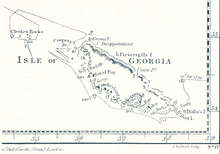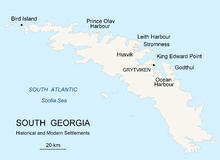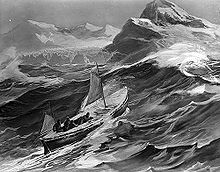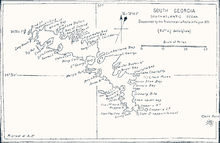History of South Georgia and the South Sandwich Islands
This article provides an overview of the history of the British Territory of South Georgia and the South Sandwich Islands in the Southern Ocean . Before they were discovered by European seafarers, the islands were uninhabited. The islands were claimed for the United Kingdom by the navigator James Cook in 1775 , which is now only challenged by Argentina . Seal hunting and whaling were of great economic importance between 1786 and 1965, and since then the islands have only been temporarily inhabited by researchers and British officials. Significant fighting took place on these islands during the Falklands War .
16th to 19th century
Discovery by European sailors
The South Atlantic island of South Georgia , located south of the Antarctic Convergence , was the first Antarctic territory ever discovered.
One popular belief is that Amerigo Vespucci may have spotted South Georgia on one of his trips. In April 1502, while on a voyage in the South Atlantic at an estimated 52 ° south latitude, Vespucci allegedly spotted an island that he described as high, dark and harsh land, on which human life was made impossible by the icy cold - a description that would apply to South Georgia . However, the assumption was refuted by an analysis of Vespucci's records.
Another persistent misconception is that South Georgia may be identical to the mythical island of Pepys , which the English buccaneer William Cowley supposedly discovered in December 1683. However, according to Cowley's diary, the point where he sighted is more than 1,700 kilometers, or 920 nautical miles, north of South Georgia. It is believed that he saw one of the Falkland Islands but was wrong in determining his position.
The actual discovery, like many other early discoveries in this region, likely came as a result of bad weather that threw a ship off course. The English merchant Anthony de la Roché encountered stormy weather on the way from Chiloé to Salvador da Bahia near the Isla de los Estados , missed Le Maire Street and was driven far to the east. He found refuge in one of the south-western bays of South Georgia, where his ship was anchored for fourteen days in April 1675. Cartographers began to mark the island as "Roché Island" on their maps to honor the discoverer.
In January 1700, the area around South Georgia was explored by Sir Edmund Halley in the course of his mapping of declinations in the South Atlantic. His ship HMS Paramore (or Paramour ) penetrated the Antarctic Convergence and made it to about 170 kilometers (90 nautical miles) north of South Georgia, where Halley mistook a few flat icebergs for islands, as it may have happened to Vespucci before him.
In 1756 the island was sighted by the Spanish ship León under captain Gregorio Jerez and named San Pedro .
These early visits did not result in territorial claims by major powers. Above all, Spain - unlike in the case of the Falkland Islands - never had claims to South Georgia, which would have fallen into the area allocated to Portugal in the Treaty of Tordesillas of 1494 anyway .
Takeover for Great Britain
The first landing on South Georgia, followed by exploration and mapping, was done by James Cook . As instructed by the Admiralty , he took possession of the island for the United Kingdom on January 17, 1775 and gave it the new name "Isle of Georgia" in honor of King George III. The German naturalist Georg Forster , who accompanied Cook that day on his three landings in Possession Bay , wrote:
“Here Captain Cook unfolded the British flag and performed the ceremony of taking possession of these barren rocks, in the name of His British Majesty and His Heirs for all eternity. A volley of two or three muskets was fired. "
From South Georgia, Captain Cook sailed southeast and discovered - after naming Cape Disappointment , the Cape of Disappointment, after discovering that the island was not the Terra Australis he was looking for - the Clerke Rocks and a group of islands he named after Lord Sandwich called "Sandwich Land". The addition "southern" was necessary because Cook also named today's Hawaii with "sandwich islands". The archipelago of the South Sandwich Islands includes the islands of Candlemas , Vindication , Saunders , Montagu , Bristol , Bellingshausen , Cook and Morrell , which were discovered by Cook, and the Traversay Islands ( Zavodovski , Leskov and Visokoi ) which were discovered by the Russian expedition of Fabian Gottlieb von Bellingshausen and Mikhail Petrovich Lazarev were discovered in the ships Vostok and Mirny from 1819.
The group of Shag Rocks and Black Rock , which border the British overseas territory of South Georgia and the South Sandwich Islands to the west, lie 270 kilometers or 150 nautical miles northwest of South Georgia. They were probably discovered by the Spanish ship Aurora in 1762 , which is why they also appear as Aurora Islands on early maps . The Aurora Islands were visited and renamed by the US sealer Hersilia in 1819 . They were not mapped until 1920 by HMS Dartmouth . The Clerke Rocks east of South Georgia were discovered by Cook's commander Charles Clerke in 1775.
Since November 1909 a magistrate who represents the British government has lived continuously (except for 22 days in 1982) in South Georgia. On March 18, 1909, Argentina formally recognized British rule over the island without objection.

Seal hunting and whaling
During the late 18th and all of the 19th centuries, South Georgia was inhabited by English and US seal hunters , attracted by reports from James Cook. These lived there for some time and sometimes overwintered. The island's first seals were hunted by the English seal-hunting ship Lord Hawkesbury in 1786 , while the first commercial visit to the South Sandwich Islands was in 1816 by another English ship, the Ann .
The seal hunters ran their business in an untenable manner, and the seal population was almost wiped out in a short period of time. As a direct consequence, the seal hunting activities around South Georgia had three clear highs: 1786 to 1802, 1814 to 1823 and 1869 to 1913. The proportions of hunted elephant seals increased gradually as the extraction of tines became more important. From the beginning of the 20th century, the stocks were regulated more effectively.
In the 19th century, effective, continued and undisputed British rule over South Georgia was ensured by the British Patent of 1843, which was revised in 1876, 1892, 1908 and 1917. In addition, the island appeared in the yearbook of the colonial office from 1887. From 1881 the United Kingdom regulated economic activities through administrative laws such as the Seal Hunting Decrees of 1881 and 1899. South Georgia was ruled from the Falkland Islands , but was not politically or financially a part of it. These arrangements lasted until 1985 when South Georgia and the South Sandwich Islands became a separate British overseas territory .
20th century
In the early 20th century, South Georgia saw an unprecedented surge in economic activity and settlement. Following an advertisement from the government of the Falkland Islands, the island was rented to a company from Punta Arenas in 1900 . A subsequent conflict of interest with the Compañía Argentina de Pesca , which had been whaling from Grytviken since December 1904 , was resolved by the British authorities who, on request, transferred whaling rights to the company.
South Georgia became the world's largest whaling center - there were coastal bases in Grytviken (operated from 1904 to 1964), Leith Harbor (1909 to 1965), Ocean Harbor (1909 to 1920), Husvik (1910 to 1960), Stromness (1913 to 1961) and Prince Olav Harbor (1917 to 1931). Among the companies involved were the Compañía Argentina de Pesca , the Christian Salvesen & Co. ( UK ), the Albion Star (South Georgia) Ltd. ( Falkland Islands ), the Norwegian whaling companies Hvalfangerselskap Ocean , Tønsberg Hvalfangeri and Sandefjord Hvalfangerselskap and the Southern Whaling and Sealing Company from South Africa . In the final seasons of whaling around South Georgia, Grytviken and Leith Harbor were rented by the Japanese companies Kokusai Gyogyo Kabushike Kaisha and Nippon Suisan Kaisha (1963/64 and 1963-65, respectively). 175,250 whales were hunted in South Georgia from 1904 to 1965. Whaling also contaminated certain areas with heavy fuel oil, which is now being decontaminated.
The expansion of the Norwegian whaling industry into the Antarctic in the early 20th century motivated Norway to seek territorial expansion immediately after its independence from Sweden - and not only in the Arctic, where Jan Mayen and the Sverdrup Islands were called, but also in the Antarctic . Norway claimed Bouvet Island and then peered further south by formally inquiring with the British about the international status of the area between 45 ° and 65 ° south latitude and 35 ° and 80 ° west longitude. After a second such diplomatic move by the Norwegian government on March 4, 1907, the British government replied that the areas were British based on discoveries made in the first half of the 19th century, and in 1909 established a permanent local administration in Grytviken.
Carl Anton Larsen , the founder of Grytviken, was a naturalized British who was born in Sandefjord , Norway . In his application for British citizenship, granted in 1910, he wrote: “I have given up my rights as a Norwegian citizen and have lived here since I started whaling in this colony on November 16, 1904, and have no reason to to be of a different nationality than British, as I live here and intend to keep him here for a long time. ”His family in Grytviken also included his wife, three daughters and two sons.
As manager of the Compañía Argentina de Pesca , Larsen organized the construction of Grytviken - a remarkable undertaking that he started with a team of 60 Norwegians. Construction began on November 16, 1904 and continued until the new whale oil factory started operations on December 24 of the same year. Larsen also set up a meteorological observatory in Grytviken, which was operated from 1905 in cooperation with the Argentine Meteorological Office.
Larsen chose the site of the whaling station during his visit in 1902 while commanding the ship Antarctic of the Swedish Antarctic Expedition (1901-1903) led by Otto Nordenskjöld . On this occasion the name Grytviken ("Kesselbucht") arose; it was shaped by the Swedish archaeologist and geologist Johan Gunnar Andersson , who explored parts of the Thatcher Peninsula and found numerous artifacts such as a sloop and some pots for boiling seal oil. One of these pots with the inscription “Johnson and Sons, Wapping Dock London” can be seen today in the South Georgia Museum in Grytviken .
Most of the whalers were Norwegians, with an increasing number of British people practicing this profession. During the whaling era, the population of South Georgia typically ranged from around 1,000 in summer (sometimes over 2,000) to around 200 in winter. The first population census, carried out by the British Magistrate James Wilson on December 31, 1909 (i.e. in the polar summer), recorded a total population of 720, including three women and one child. These 720 residents were divided into 579 Norwegians, 58 Swedes, 32 British, 16 Danes, 15 Finns, 9 Germans, 7 Russians, 2 Dutch, 1 French and 1 Austrian.
Whaling station chiefs and other senior officials often lived with their families. For example, Fridthjof Jacobsen lived with his wife Klara Olette Jacobsen, who gave birth to two of their three children in Grytviken; their daughter Solveig Gunbjørg Jacobsen was the first child ever born in Antarctica (October 8, 1913). Several children were later born in South Georgia, even today on board private yachts.
There are about 200 tombs on the island dating from 1820 to the present day; including that of the well-known Antarctic explorer Sir Ernest Shackleton († 1922), whose Nimrod expedition from 1908 to 1909 established the route to the South Pole, which was later also used by Roald Amundsen and Robert Scott . In one of the most remarkable voyages in naval history in a small boat, Shackleton crossed the Scotia Sea in 1916 in the 7-meter-long boat James Caird to reach South Georgia and organize the successful rescue of his expedition team stranded on Elephant Island . As a result, Shackleton, accompanied by Frank Worsley and Tom Crean, crossed the icy and wild land between King Haakon Bay and the Stromness whaling station .
In 1928 Carl Anton Larsen's son-in-law, the researcher Ludwig Kohl-Larsen , visited South Georgia with his wife and cameraman Albert Benitz and carried out a scientific expedition to explore the island.
Second World War
During the Second World War all whaling stations were closed except for Grytviken and Leith Harbor. Most of the British and Norwegian factories and whaling ships were destroyed by German warships, while the remainder were drafted under Allied command. British Magistrates W. Barlas and Al Fleuret took over the defense of the island during the war. The Royal Navy armed the merchant ship Queen of Bermuda to patrol the waters around South Georgia. In addition, two 102 mm cannons were set up at key points to protect the access to Cumberland Bay and Stromness Bay , i.e. to Grytviken and Leith Harbor. These still-present batteries were manned by volunteers from among the Norwegian whalers who had been trained for this purpose.
Falklands War
The first official announcement of Argentine claims on South Georgia did not surface until 1927. The first clear claim about the South Sandwich Islands did not even appear until 1938. After the United Kingdom had proposed several times that the claims should be clarified by the International Court of Justice , it submitted a unilateral application in 1955, but no hearing took place as both Argentina and Chile , which was also involved in disputes, made it clear that they had jurisdiction over the Court not recognized.
On November 7, 1976, the Argentine naval station Corbeta Uruguay was secretly established on Morrell , which was the cause of some official British protests, the first of which came out on January 19, 1977. Arrangements to legalize the station were discussed in 1978 but were not reached. In an early phase of the Falklands War , 32 members of a special unit were brought from Corbeta Uruguay to South Georgia by the Argentine ship Bahía Paraiso , where they landed in Leith Harbor on March 25, 1982.
Together with the Corvette Guerrico, the Bahía Paraiso attacked the platoon of 22 Royal Marines stationed in Grytviken on April 3rd . As a result of the two-hour battle, the Guerrico was badly damaged and an Argentine helicopter was shot down. The Argentines lost three men and some were injured. The British, on the other hand, had only one wounded to complain about. The British Commanding Officer, Lieutenant Keith Mills, was awarded the Distinguished Service Cross for the defense of South Georgia . While the British magistrate and other civil and military persons were evacuated from the island, 15 British people remained out of reach of the Argentines, who barely moved outside of their bases. The losses suffered at Grytviken prevented the Argentines from occupying the rest of the island, so the Bird Island base and encampments at Schlieper Bay, Lyell Glacier and St. Andrews Bay remained under British control.

The South Georgia Force that was tasked with conducting Operation Paraquet consisted of the destroyer HMS Antrim and the frigate HMS Plymouth with troops from Special Air Service (SAS) and Special Boat Service (SBS) on board and a company of the Royal Marines on the auxiliary ship RFA Tidespring . After it was first established by submarines and reconnaissance planes that there were no Argentine ships in the vicinity of the island, scouts from the SAS and SBS were sent to the island. On April 25, 1982, the Royal Navy severely damaged the Argentine submarine Santa Fé off South Georgia and captured the crew. An improvised attack with 72 men followed because the auxiliary troops of the Tidespring were still too far away. The Argentine garrison in Grytviken gave up without a shot after the British demonstrated their firepower with 235 rounds, just as the troops in Leith Harbor did the following day. Finally, on June 20, 1982, the Argentines were removed from the South Sandwich Islands and South Georgia by the HMS Endurance . In January 1983, the Corbeta Uruguay station was destroyed.
Since the Falklands War , Great Britain had a small garrison of Royal Engineers in South Georgia until it had to give way to a research team in March 2001.
Scientific Research
Since the Cook and Bellingshausen expeditions, the waters and coast of South Georgia have been explored by a number of other undertakings. Above all, the extensive oceanographic investigations of the Discovery Committee from 1925 to 1951 brought in an enormous amount of scientific data, such as the discovery of the Antarctic Convergence . The first scientific, land-related expedition to South Georgia was carried out from August 20, 1882 to September 6, 1883 under the direction of the German astronomer Carl Schrader in the course of the First International Polar Year in Moltke Harbor, Royal Bay .
Another Antarctic explorer with a special place in the history of South Georgia was Duncan Carse (1913-2004). His contiguous mapping of the island from 1951 to 1957 as part of the South Georgia Survey resulted in the classic 1: 200,000 map of South Georgia, which has been updated occasionally since its first publication in 1958, but never replaced. In 1961 Carse carried out an experiment lasting several months in which he lived alone in a secluded place on the southwest coast of the island ( Ducloz Head ). The third highest mountain on the island, Mount Carse , is named after him.
today
Due to its remote location and harsh climate, South Georgia still has no indigenous population. Although the island has been inhabited for the past two centuries, some settlers have stayed there for decades, and children have been born and raised, no family has settled there for more than a generation. Today's inhabited places are Grytviken , King Edward Point, and Bird Island . King Edward Point is the port of entry and residence of the UK Magistrate and Port , Customs , Immigration , Fisheries and Postal Authorities . It is commonly known as “Grytviken” in association with the abandoned whaling station, which is regularly visited by cruise ships, which is about 800 meters away. The island government maintains cabins in Sörling Valley , Dartmouth Point , Maiviken , St. Andrews Bay , Corral Bay , Carlita Bay , Jason Harbor , Ocean Harbor and Lyell Glacier . Two people still live in South Georgia today, Pat and Sarah Lurcock.
The uninhabited South Sandwich Islands are even less hospitable; they too are affected by volcanic activity. Since 1995 the South African weather office has maintained two automatic weather stations on the islands of Zavodovski and Morrell .
Old maps
- Guillaume de L'Isle, Henry A. Chatelain: Carte du Paraguai, you Chili, you Detroit de Magellan . Paris, 1705/19 (Map shows Roché Island.)
- Richard W. Seale: A Map of South America. With all the European Settlements & whatever else is remarkable from the latest & best observations . London, around 1745. (Map shows Roché Island.)
- Thomas Jefferys : South America . London, 1768. (Map shows Roché Island.)
- James Cook: Chart of the Discoveries made in the South Atlantic Ocean, in His Majestys Ship Resolution, under the Command of Captain Cook, in January 1775 ; W. Strahan and T. Cadel, London, 1777.
literature
- Capt. Francisco de Seixas y Lovera: Descripcion geographica, y derrotero de la region austral Magallanica. Que se dirige al Rey nuestro señor, gran monarca de España, y sus dominios en Europa, Emperador del Nuevo Mundo Americano, y Rey de los reynos de la Filipinas y Malucas . Antonio de Zafra, Madrid 1690. (Narrated about the discovery of South Georgia by the Englishman Anthony de la Roché in April 1675; relevant fragment here, English .)
- William Ambrosia Cowley: Cowley's Voyage Round the Globe , in Collection of Original Voyages , ed. William Hacke, James Knapton, London 1699.
- George Forster: A Voyage Round the World in His Britannic Majesty's Sloop Resolution Commanded by Capt. James Cook, during the Years 1772, 3, 4 and 5 (2 vols.) , London 1777.
- James Cook: A Voyage Towards the South Pole, and Round the World. Performed in His Majesty's Ships the Resolution and Adventure, In the Years 1772, 1773, 1774, and 1775. In which is included, Captain Furneaux's Narrative of his Proceedings in the Adventure during the Separation of the Ships . Volume II. Printed for W. Strahan and T. Cadell, London 1777. ( Relevant fragment here, English )
- Capt. Isaac Pendleton: South Georgia; Southatlantic Ocean: Discovered by the Frenchman La Roche in the year 1675 , 1802, reproduced by A. Faustini, Rome 1906. (The second map of South Georgia; Pendleton was wrong about the nationality of la Roche, who was an Englishman but a French father would have had.)
- Otto Nordenskjöld, Johan G. Andersson, Carl A. Larsen: Antarctica, or Two Years Among the Ice of the South Pole . Hurst & Blackett, London 1905.
- Otto Wilckens: Paleontological and geological results of the trip of Kohl-Larsen (1928-29) to South Georgia . Kramer, Frankfurt am Main 1947.
- Robert K. Headland: The Island of South Georgia , Cambridge University Press, 1986, ISBN 0-521-25274-1
- Roger Perkins: Operation Paraquat , Picton (Chippenham) 1986, ISBN 0-948251-13-1 (Describes the 1982 Argentine invasion and defeat)
- Alan Edwin Day: The Falkland Islands, South Georgia and the South Sandwich Islands . Clio Press, Oxford 1996, ISBN 1-85109-236-6
- Sally Poncet and Kim Crosbie: A Visitor's Guide to South Georgia . Wildguides 2005, ISBN 1-903657-08-3
- Historia de las Relaciones Exteriores Argentinas, Obra dirigida por Carlos Escudé y Andrés Cisneros, desarrollada y publicada bajo los auspicios del Consejo Argentino para las Relaciones Internacionales (CARI). GEL / Nuevohacer (Buenos Aires), 2000
Web links
- Capt. Francisco de Seixas y Lovera: Descripcion geographica, y derrotero de la region austral Magallanica. Antonio de Zafra, Madrid 1690. Relevant fragment, Spanish
- South Georgia Heritage Trust: Society for the Conservation of the Environment
- Page about the cemeteries of South Georgia
- Page about South Georgia with a history . Archived from the original on November 24, 1999. Retrieved September 21, 2013.
Individual evidence
- ↑ This article (version of February 24, 2008) is based on a translation from English
- ↑ Forster 1777, p. literature
- ↑ Whaling Stations on South Georgia Island , from the Fundación Histarmar website , accessed July 12, 2016.
- ↑ Odd Gunnar Skagestad: Norsk Polar Politikk: Hovedtrekk og Utvikslingslinier, 1905–1974 . Dreyers Forlag, Oslo 1975
- ↑ Thorleif Tobias Thorleifsson: Bi-polar international diplomacy: The Sverdrup Islands question, 1902-1930 . (PDF) Master of Arts Thesis, Simon Fraser University, 2004.
- ^ Otto Wilckens: Paleontological and geological results of the trip of Kohl-Larsen (1928-1929) to South Georgia . Kramer, Frankfurt am Main 1947. passim
- ↑ Robert E. Wilson: National interests and claims in the Antarctic , Arctic, Vol. 17, Arctic Institute of North America, Calgary 1964, p. 25 ( online ; PDF; 1.3 MB)
- ↑ Britain's Small Wars: The Argentine Invasion of South Georgia ( Memento of the original from October 14, 2007 in the Internet Archive ) Info: The archive link was automatically inserted and not yet checked. Please check the original and archive link according to the instructions and then remove this notice.













